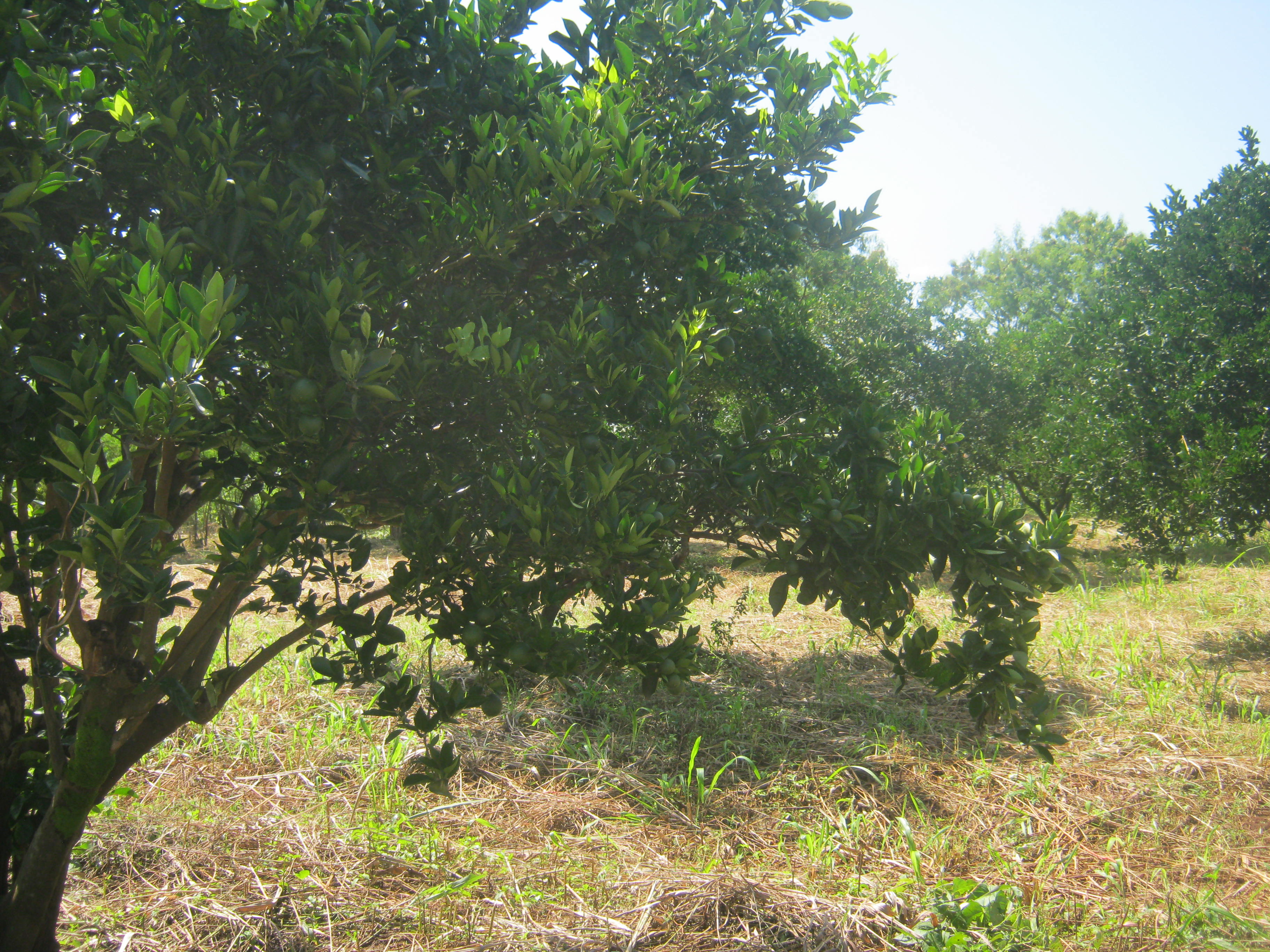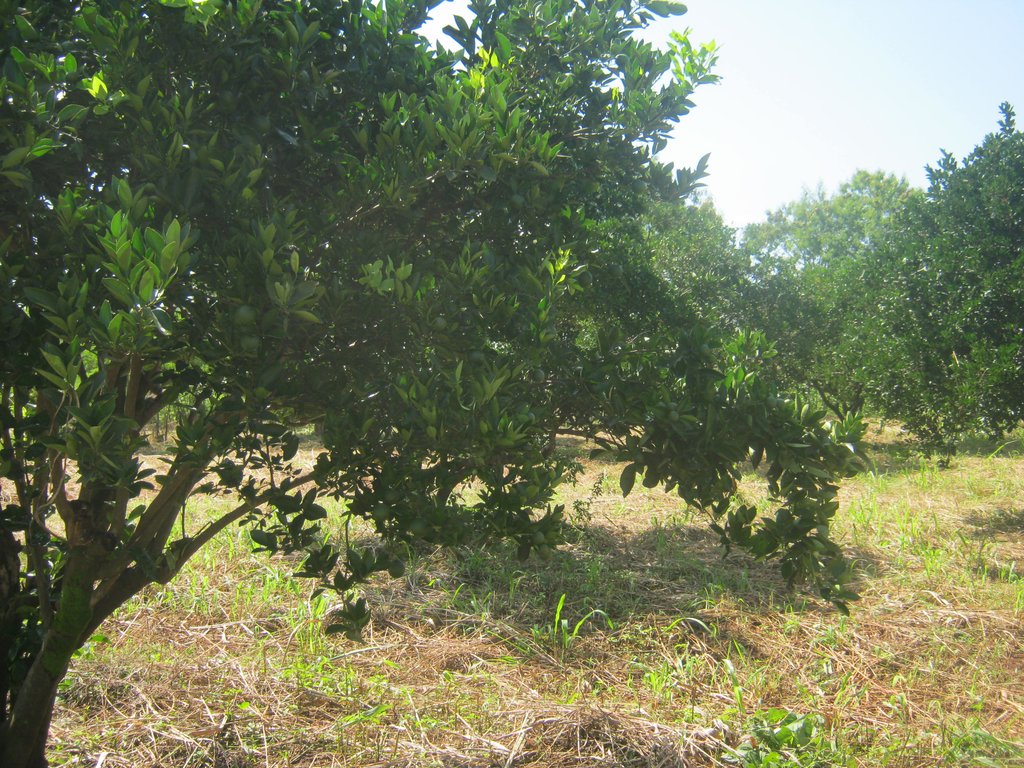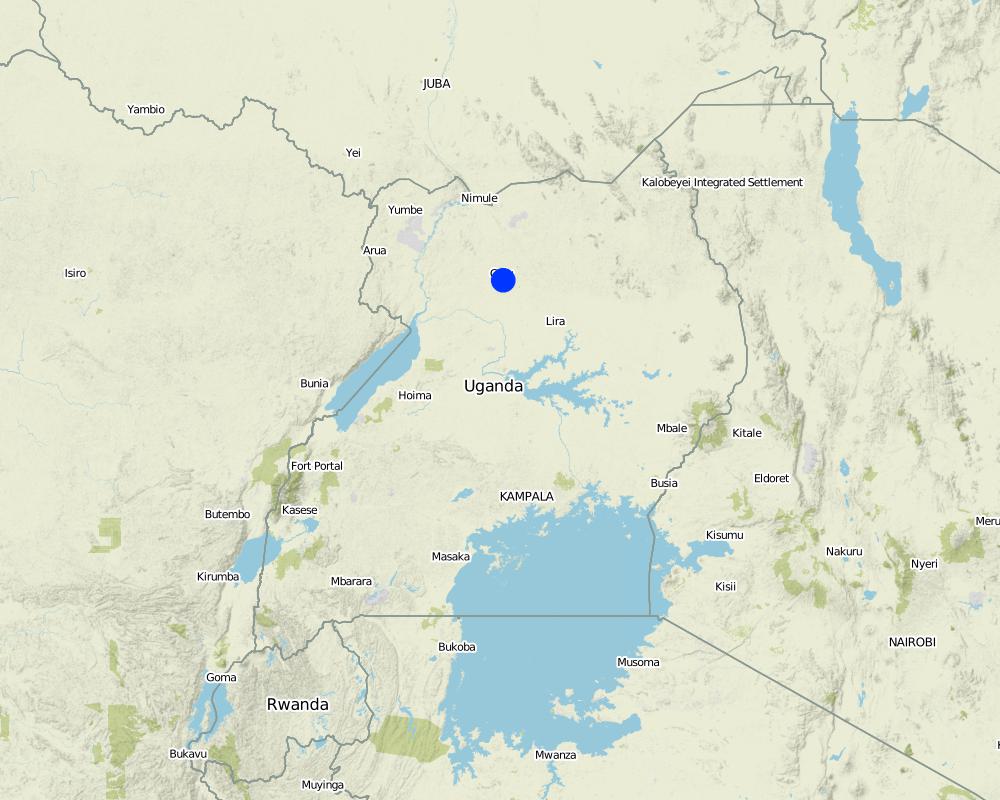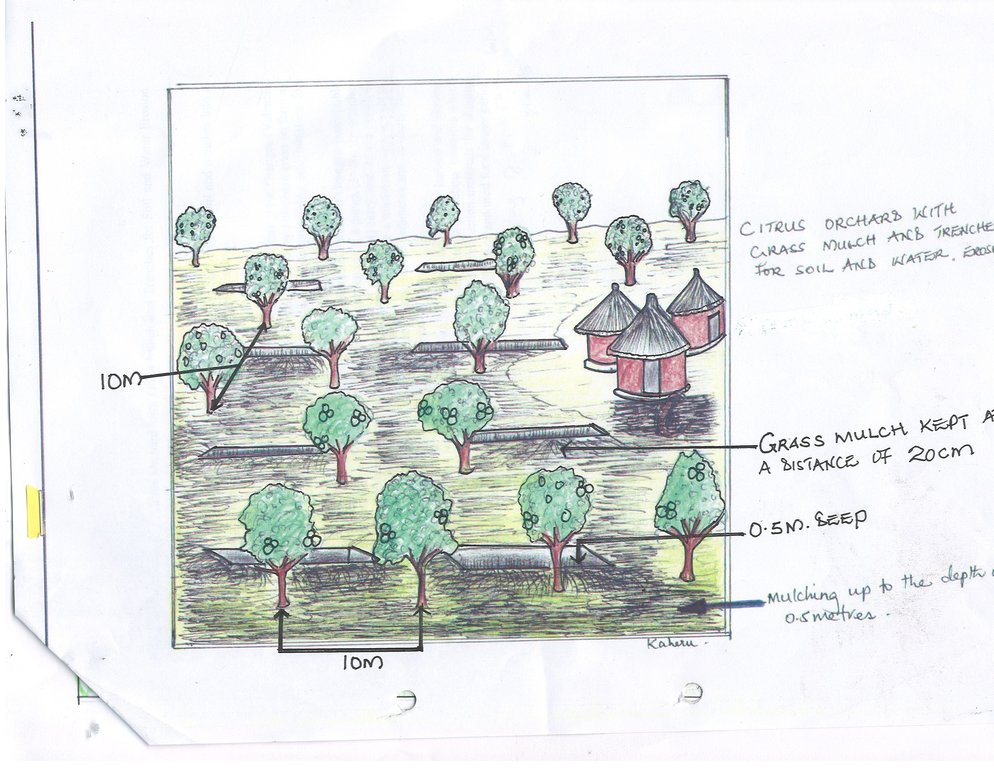Citrus Orchard with Grass Mulch and Trenches for Soil Erosion Control [乌干达]
- 创建:
- 更新:
- 编制者: Kamugisha Rick Nelson
- 编辑者: JOY TUKAHIRWA, Richard Otto Kawawa, Sunday Balla Amale, Bernard Fungo
- 审查者: Drake Mubiru, Nicole Harari, Renate Fleiner
Poto mucungwa , magiumu kilum pi gengo kitete
technologies_2826 - 乌干达
查看章节
全部展开 全部收起1. 一般信息
1.2 参与该技术评估和文件编制的资源人员和机构的联系方式
关键资源人
土地使用者:
Oduor Alex w
0779835993
Farmer
Gulu
乌干达
有助于对技术进行记录/评估的项目名称(如相关)
Scaling-up SLM practices by smallholder farmers (IFAD)有助于对技术进行记录/评估的机构名称(如相关)
Uganda Landcare Network (ULN) - 乌干达1.3 关于使用通过WOCAT记录的数据的条件
(现场)数据是什么时候汇编的?:
2/4/2017
编制者和关键资源人员接受有关使用通过WOCAT记录数据的条件。:
是
1.4 所述技术的可持续性声明
这里所描述的技术在土地退化方面是否存在问题,导致无法被认为是一种可持续的土地管理技术?:
否
2. SLM技术的说明
2.1 技术简介
技术定义:
Integrating black spear grass (Heteropogon Contortus), elephant grass (Pennisetum Purpureum) and trenches into a Citrus orchard of Oranges (Citrus Sinensis) for soil and water erosion control.
2.2 技术的详细说明
说明:
Farmers in Northern Uganda with an average size of 0.5 acres of land or more grow Oranges (Valencia and Anlin) varieties planted with a spacing of 10 x10 m and integrate them with the use of locally obtained black spear grass and elephant grass on farm as mulching materials and trenches to slow down rainwater runoff while preserving soil moisture for increased production and household income. Citrus orchard of oranges (Citrus sinensis ) with grass mulch and trenches is established on gently sloping land with grasses every year. The trenches are established within the citrus orchard for soil erosion control and environmental and water conservation.To establish this technology the land user will (1) identify an already planted Orchard of Oranges susceptible to soil and water erosion problems, (2) clear the grasses in the garden using a panga, (3) dig the trenches using a hoe, a spade and labour up to a depth of not more than 0.5 centimetres, (4) carry and lay the mulch to the garden using at least 3-4 workers per day with the grass mulch kept at a minimum distance of 20 centimetres away from the plant to allow for air circulation, (5) remove the sediments and re-apply them back to the field once the trenches are filled with the sediments. Mulched grass decomposes over time, improves fertility while trenches allow water harvesting and prevent soil and water erosion. However, the land user needs to be aware that trenches are labour intensive which could be the most expensive input, in addition to the cost of basic construction materials for digging trenches like a hoe, a panga and a spade which are in most cases bought once and used for a longer period of time. The benefits derived from this SLM technology are high in the long run as the technology is suitable for improving soil fertility and controlling soil erosion with the established grass mulch and trenches. Trenches and grass mulch retain water during heavy rains which is utilized by citrus during the dry season. The leaf litter from a citrus garden with minimum tillage when decomposed provides manure to enhance crop production generating increased income from the sale of fruits. However, this technology requires labour for planting, cutting the grass , watering and constructing the trenches which accounts for most of the costs. What is not liked about this technology is that the trenches are not easy to make and are labour-intensive.
2.3 技术照片
2.5 已应用该技术的、本评估所涵盖的国家/地区/地点
国家:
乌干达
区域/州/省:
Northern Region,Uganda
有关地点的进一步说明:
Gulu District
Map
×2.6 实施日期
注明实施年份:
2011
如果不知道确切的年份,请说明大概的日期:
- 不到10年前(最近)
2.7 技术介绍
详细说明该技术是如何引入的:
- 通过土地使用者的创新
3. SLM技术的分类
3.1 该技术的主要目的
- 改良生产
- 减少、预防、恢复土地退化
- 适应气候变化/极端天气及其影响
- 创造有益的经济影响
3.2 应用该技术的当前土地利用类型

混合(作物/放牧/树木),包括农林
- 农林业
主要产品/服务:
Orchard of Oranges
3.3 有关土地利用的更多信息
该技术所应用土地的供水:
- 雨养
每年的生长季节数:
- 2
具体说明:
Twice a year: April-May and August-November
牲畜密度(如相关):
N/A
3.4 该技术所属的SLM组
- 农业林学
- 土壤肥力综合管理
3.5 技术传播
具体说明该技术的分布:
- 均匀地分布在一个区域
如果该技术均匀地分布在一个区域上,请注明覆盖的大致区域。:
- < 0.1 平方千米(10 公顷)
3.6 包含该技术的可持续土地管理措施

农艺措施
- A1:植被和土壤覆盖层
- A2:有机质/土壤肥力
- A3:土壤表面处理

植物措施
- V1:乔木和灌木覆盖层
3.7 该技术强调的主要土地退化类型

土壤水蚀
- Wt:表土流失/地表侵蚀
- Wg:冲沟侵蚀/沟蚀

土壤风蚀
- Et:表土流失

化学性土壤退化
- Cn:肥力下降和有机质含量下降(非侵蚀所致)
3.8 防止、减少或恢复土地退化
具体数量名该技术与土地退化有关的目标:
- 防止土地退化
- 减少土地退化
注释:
The technology prevents soil degradation through litter and decomposition of the mulched grass. The integrated trenches also help retain water for citrus production.
4. 技术规范、实施活动、投入和成本
4.1 该技术的技术图纸
4.2 技术规范/技术图纸说明
The vertical drawing only contains citrus fruits of oranges that are planted integrated with grass mulch and trenches for soil and water conservation. Mulching should be done up to a depth 0.5 cm with the mulch kept at a minimum of 20 cm away from the plant to allow for air circulation. Digging of the trench is done at a depth of 0.5 metres with the spacing of 10mx10m between the Orange trees.
4.3 有关投入和成本计算的一般信息
具体说明成本和投入是如何计算的:
- 每个技术区域
注明尺寸和面积单位:
1 acre
其它/国家货币(具体说明):
UGX
注明美元与当地货币的汇率(如相关):1美元=:
3400.0
注明雇用劳工的每日平均工资成本:
5000
4.4 技术建立活动
| 活动 | 措施类型 | 时间 | |
|---|---|---|---|
| 1. | Identify the citrus orchard with spear grass | 农业学的 | Once before before establishment |
| 2. | Cut the spear grass | 植物性的 | Once before establishment |
| 3. | Dig the trenches | 结构性的 | Once during establishment |
| 4. | Carry the grass | 其它措施 | During establishment |
| 5. | Lay the grass | 结构性的 | During establishment |
4.5 技术建立所需要的费用和投入
| 对投入进行具体说明 | 单位 | 数量 | 单位成本 | 每项投入的总成本 | 土地使用者承担的成本% | |
|---|---|---|---|---|---|---|
| 劳动力 | Persons days hired per month | persons | 10.0 | 7000.0 | 70000.0 | 100.0 |
| 设备 | Spades | Pieces | 5.0 | 10000.0 | 50000.0 | 100.0 |
| 设备 | Hoe | Pieces | 10.0 | 10000.0 | 100000.0 | 100.0 |
| 设备 | A -frame | Pieces | 2.0 | 15000.0 | 30000.0 | 100.0 |
| 设备 | Panga | Pieces | 4.0 | 7000.0 | 28000.0 | 100.0 |
| 技术建立所需总成本 | 278000.0 | |||||
4.6 维护/经常性活动
| 活动 | 措施类型 | 时间/频率 | |
|---|---|---|---|
| 1. | Removing soil in the trenches | 其它措施 | Every time the trench is re-filled with soil |
4.7 维护/经常性活动所需要的费用和投入(每年)
| 对投入进行具体说明 | 单位 | 数量 | 单位成本 | 每项投入的总成本 | 土地使用者承担的成本% | |
|---|---|---|---|---|---|---|
| 劳动力 | Persons days on ddaily basis | Persons | 4.0 | 7000.0 | 28000.0 | 100.0 |
| 技术维护所需总成本 | 28000.0 | |||||
4.8 影响成本的最重要因素
描述影响成本的最决定性因素:
Labour for digging trenches , cutting and carrying grass is the most expensive input affecting the costs.
5. 自然和人文环境
5.1 气候
年降雨量
- < 250毫米
- 251-500毫米
- 501-750毫米
- 751-1,000毫米
- 1,001-1,500毫米
- 1,501-2,000毫米
- 2,001-3,000毫米
- 3,001-4,000毫米
- > 4,000毫米
指定年平均降雨量(若已知),单位为mm:
1350.00
有关降雨的规范/注释:
The area experiences two rainy seasons per year, in March to April and in September to November, with a dry season around December to March.
农业气候带
- 半湿润
5.2 地形
平均坡度:
- 水平(0-2%)
- 缓降(3-5%)
- 平缓(6-10%)
- 滚坡(11-15%)
- 崎岖(16-30%)
- 陡峭(31-60%)
- 非常陡峭(>60%)
地形:
- 高原/平原
- 山脊
- 山坡
- 山地斜坡
- 麓坡
- 谷底
垂直分布带:
- 0-100 m a.s.l.
- 101-500 m a.s.l.
- 501-1,000 m a.s.l.
- 1,001-1,500 m a.s.l.
- 1,501-2,000 m a.s.l.
- 2,001-2,500 m a.s.l.
- 2,501-3,000 m a.s.l.
- 3,001-4,000 m a.s.l.
- > 4,000 m a.s.l.
说明该技术是否专门应用于:
- 凹陷情况
5.3 土壤
平均土层深度:
- 非常浅(0-20厘米)
- 浅(21-50厘米)
- 中等深度(51-80厘米)
- 深(81-120厘米)
- 非常深(> 120厘米)
土壤质地(表土):
- 中粒(壤土、粉土)
土壤质地(地表以下> 20厘米):
- 细粒/重质(粘土)
表土有机质:
- 中(1-3%)
5.4 水资源可用性和质量
地下水位表:
5-50米
地表水的可用性:
中等
水质(未处理):
不良饮用水(需要处理)
水的盐度有问题吗?:
否
该区域正在发生洪水吗?:
否
5.5 生物多样性
物种多样性:
- 中等
栖息地多样性:
- 中等
5.6 应用该技术的土地使用者的特征
定栖或游牧:
- 定栖的
生产系统的市场定位:
- 混合(生计/商业
非农收入:
- 低于全部收入的10%
相对财富水平:
- 平均水平
个人或集体:
- 个人/家庭
- 团体/社区
机械化水平:
- 手工作业
性别:
- 女人
- 男人
土地使用者的年龄:
- 青年人
- 中年人
说明土地使用者的其他有关特征:
Grass mulching is mostly done by both men and women because it is easier work, compared to trenches which are mostly done by men because of their labour intensiveness.
5.7 应用该技术的土地使用者拥有或租用的平均土地面积
- < 0.5 公顷
- 0.5-1 公顷
- 1-2 公顷
- 2-5公顷
- 5-15公顷
- 15-50公顷
- 50-100公顷
- 100-500公顷
- 500-1,000公顷
- 1,000-10,000公顷
- > 10,000公顷
这被认为是小规模、中规模还是大规模的(参照当地实际情况)?:
- 小规模的
5.8 土地所有权、土地使用权和水使用权
土地所有权:
- 社区/村庄
- 个人,未命名
土地使用权:
- 社区(有组织)
- 个人
用水权:
- 社区(有组织)
- 个人
5.9 进入服务和基础设施的通道
健康:
- 贫瘠
- 适度的
- 好
教育:
- 贫瘠
- 适度的
- 好
技术援助:
- 贫瘠
- 适度的
- 好
就业(例如非农):
- 贫瘠
- 适度的
- 好
市场:
- 贫瘠
- 适度的
- 好
能源:
- 贫瘠
- 适度的
- 好
道路和交通:
- 贫瘠
- 适度的
- 好
饮用水和卫生设施:
- 贫瘠
- 适度的
- 好
金融服务:
- 贫瘠
- 适度的
- 好
6. 影响和结论性说明
6.1 该技术的现场影响
社会经济效应
生产
土地管理
注释/具体说明:
The technology relies on use of locally obtained grass mulch within the field.
收入和成本
农业投入费用
注释/具体说明:
The technology requires inputs like hoes, pangas and spades which are not very expensive.
工作量
注释/具体说明:
Requires more labour for digging trenches and carrying grass mulch at the time of establishment.
社会文化影响
SLM/土地退化知识
生态影响
水循环/径流
水的回收/收集
地表径流
注释/具体说明:
Due to mulching grass and trenches
土壤
土壤水分
土壤覆盖层
土壤流失
6.2 该技术的场外影响已经显现
水资源可用性
注释/具体说明:
Retained by the trenches and grass much
6.3 技术对渐变气候以及与气候相关的极端情况/灾害的暴露和敏感性(土地使用者认为的极端情况/灾害)
渐变气候
渐变气候
| 季节 | 气候变化/极端天气的类型 | 该技术是如何应对的? | |
|---|---|---|---|
| 年温度 | 增加 | 适度 | |
| 年降雨量 | 增加 | 好 | |
| 季雨量 | 湿季/雨季 | 减少 | 适度 |
气候有关的极端情况(灾害)
气候灾害
| 该技术是如何应对的? | |
|---|---|
| 干旱 | 适度 |
生物灾害
| 该技术是如何应对的? | |
|---|---|
| 流行病 | 适度 |
6.4 成本效益分析
技术收益与技术建立成本相比如何(从土地使用者的角度看)?
短期回报:
轻度消极
长期回报:
积极
技术收益与技术维护成本/经常性成本相比如何(从土地使用者的角度看)?
短期回报:
积极
长期回报:
积极
注释:
In the short run, the costs of digging trenches and carrying grass are more than the benefits. Benefits include that mulched grass improves the soil fertility and trenches allow water harvesting and prevention of soil and water erosion. In the short term, the digging of trenches are the most expensive input.
6.5 技术采用
- 1-10%
在所有采用这项技术的人当中,有多少人是自发地采用该技术,即未获得任何物质奖励/付款?:
- 0-10%
6.6 适应
最近是否对该技术进行了修改以适应不断变化的条件?:
否
6.7 该技术的优点/长处/机会
| 土地使用者眼中的长处/优势/机会 |
|---|
| The technology is replicable and can be promoted elsewhere by other land users (small and large scale land users). |
| More benefits in terms of low labour requirements, soil fertility improvement and increased income from the sale of fruits in the long run. A reduction in labour requirements Implies low costs incurred to pay labour. |
| Trenches and Grass mulch retain water during heavy rains which is utilized by citrus during the dry season. When the leaves of the citrus trees falls down, they decompose form manure that enhances citrus production. |
| 编制者或其他关键资源人员认为的长处/优势/机会 |
|---|
| The technology is cost effective with high costs of investment at establishment but high benefits in the long run (increased income, soil erosion control and provision of fruits for home consumption and sale). |
6.8 技术的弱点/缺点/风险及其克服方法
| 土地使用者认为的弱点/缺点/风险 | 如何克服它们? |
|---|---|
| Labour intensive | Use of family or hired labour or even work in groups. |
| 编制者或其他关键资源人员认为的弱点/缺点/风险 | 如何克服它们? |
|---|---|
| The technology is very costly and not readily for small scale land users | Link land users to SACCO's where they can obtain credit at low interest rates. |
| Very difficult for women to adopt when it comes to making trenches | Women can hire men to help or form joint working groups with men focusing on trench making as a business. |
7. 参考和链接
7.1 信息的方法/来源
- 实地考察、实地调查
02
- 与土地使用者的访谈
01
链接和模块
全部展开 全部收起链接
无链接
模块
无模块






